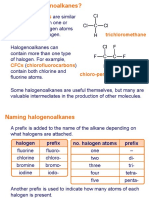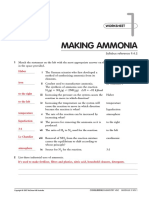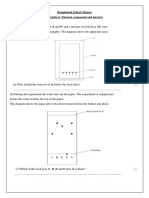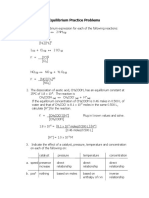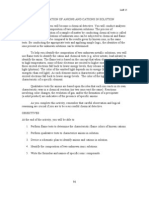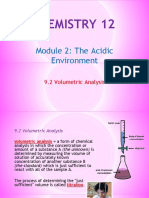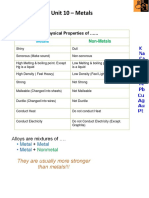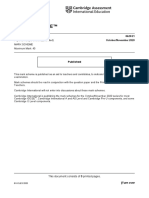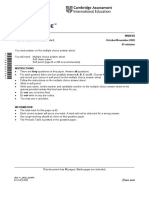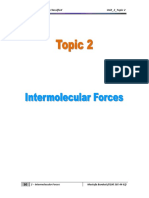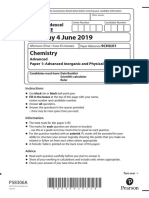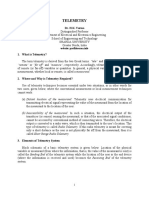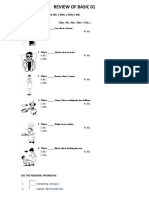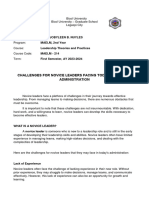2 - Elemetns, Compounds and Mixtures
2 - Elemetns, Compounds and Mixtures
Uploaded by
mostafa barakatCopyright:
Available Formats
2 - Elemetns, Compounds and Mixtures
2 - Elemetns, Compounds and Mixtures
Uploaded by
mostafa barakatOriginal Description:
Original Title
Copyright
Available Formats
Share this document
Did you find this document useful?
Is this content inappropriate?
Copyright:
Available Formats
2 - Elemetns, Compounds and Mixtures
2 - Elemetns, Compounds and Mixtures
Uploaded by
mostafa barakatCopyright:
Available Formats
Edexcel International GCSE Chemistry (9-1) Classified 4CH1_2C_Topic 2
8 2 – Elements, Compounds and Mixtures Mostafa Barakat (0100 165 44 62)
Edexcel International GCSE Chemistry (9-1) Classified 4CH1_2C_Topic 2
1) Sample Assessment 2011 Q (1)
1. Paper chromatography can be used to separate a mixture of food dyes (M),
and identify which dyes are present. The diagram shows the apparatus used.
(a) The food dyes are placed on the paper about 2 cm up from the bottom
edge. Why is it important not to place them at the bottom of the paper?
............................................................................................................................
............................................................................................................................
(1)
(b) State two observations you would make during the experiment.
1 .........................................................................................................................
............................................................................................................................
2 .........................................................................................................................
............................................................................................................................
(2)
9 2 – Elements, Compounds and Mixtures Mostafa Barakat (0100 165 44 62)
Edexcel International GCSE Chemistry (9-1) Classified 4CH1_2C_Topic 2
(c) At the end of the experiment the paper is removed and dried. The diagram
shows the paper.
(i) Measure the distance moved, in centimeters, by food dye R during the
experiment.
............................................................................................................................
(1)
(ii) Which of the food dyes P, Q, R and S are present in M?
............................................................................................................................
(1)
(iii) Food dyes P and S did not move very far. Suggest one change you could
make to this experiment to help them move further.
............................................................................................................................
(1)
10 2 – Elements, Compounds and Mixtures Mostafa Barakat (0100 165 44 62)
Edexcel International GCSE Chemistry (9-1) Classified 4CH1_2C_Topic 2
2) Jan 2013 Q (2)
2 A student produces this chromatogram for four dyes, A, B, C and D.
(i) Which one of the dyes contains three colours?
(1)
(ii) Which one of the dyes contains one colour only?
(1)
11 2 – Elements, Compounds and Mixtures Mostafa Barakat (0100 165 44 62)
Edexcel International GCSE Chemistry (9-1) Classified 4CH1_2C_Topic 2
(b) Each dye is made from one or more of the colours blue, red and yellow.
The student thinks that the result for one dye is incorrect.
Suggest which result is incorrect. Explain your answer.
(2)
The incorrect result is .........................................................................................
because .............................................................................................................
............................................................................................................................
3) June 2013 Q (1)
The box shows some methods that can be used in separating mixtures.
From the box, select the best method for each of the separations.
You may use each method once, more than once or not at all.
(a) Removing sand from a mixture of sand and water.
(1)
............................................................................................................................
(b) Obtaining pure water from a salt solution.
(1)
............................................................................................................................
(c) Extracting the red dye from a sample of rose petals.
(1)
............................................................................................................................
(d) Separating the coloured dyes in a sample of green ink.
(1)
............................................................................................................................
(e) Obtaining ethanol (alcohol) from a mixture of ethanol and water.
(1)
............................................................................................................................
12 2 – Elements, Compounds and Mixtures Mostafa Barakat (0100 165 44 62)
Edexcel International GCSE Chemistry (9-1) Classified 4CH1_2C_Topic 2
4) June 2013 Q (5_b)
(b) In February 2005, some companies had to remove their pizzas from sale
because the food colourings in them were found to contain the artificial dye
called Sudan 1, which is known to cause cancer.
The chromatogram shows how the dyes in the colourings were detected and
identified.
(i) Which one of the food colourings, A, B, C or D, is made up of only one
dye?
(1)
............................................................................................................................
(ii) Identify the food colourings that may have contained Sudan 1.
(1)
............................................................................................................................
(iii) Explain how the chromatogram shows that the five food colourings are
different from each other.
(1)
............................................................................................................................
............................................................................................................................
............................................................................................................................
............................................................................................................................
............................................................................................................................
13 2 – Elements, Compounds and Mixtures Mostafa Barakat (0100 165 44 62)
Edexcel International GCSE Chemistry (9-1) Classified 4CH1_2C_Topic 2
5) June 2014 Q (1)
1 A student investigates some food colourings, each of which is made up of
one or more dyes.
She produces a chromatogram using the safe colourings red (SR), blue (SB)
and green (SG) and food colourings red (FR), blue (FB) and green (FG).
The diagram shows her chromatogram.
(a) How many dyes are there in SR?
(1)
(b) Complete the table by placing ticks () next to the two food colourings that
are definitely safe to use.
Explain your answer.
(2)
Food colouring Safe to use?
FR
FB
FG
explanation .........................................................................................................
............................................................................................................................
............................................................................................................................
14 2 – Elements, Compounds and Mixtures Mostafa Barakat (0100 165 44 62)
Edexcel International GCSE Chemistry (9-1) Classified 4CH1_2C_Topic 2
6) June 2014 Q (2)
2 This apparatus is used to separate a mixture of ethanol (boiling point 78 °C)
and water (boiling point 100 °C).
(a) What is the name of this method of separation?
(1)
............................................................................................................................
(b) Why can ethanol and water be separated by this method?
(1)
............................................................................................................................
............................................................................................................................
(c) Suggest why water should enter the condenser at A rather than B.
(1)
............................................................................................................................
............................................................................................................................
(d) Explain why the first liquid to be collected in the beaker is mostly ethanol.
(1)
............................................................................................................................
............................................................................................................................
15 2 – Elements, Compounds and Mixtures Mostafa Barakat (0100 165 44 62)
Edexcel International GCSE Chemistry (9-1) Classified 4CH1_2C_Topic 2
7) Jan 2016 Q (1)
1 The table shows the names of some common pieces of laboratory
apparatus used to make measurements.
(a) Complete the table to show the name of the quantity that can be measured
by each piece of apparatus, and a common unit used for that quantity. One
example of each has been done for you.
(6)
Apparatus Quantity Unit
Balance mass
Stop clock S
Gas syringe
Ruler
(b) Which piece of apparatus is needed to make measurements in a paper
chromatography experiment?
(1)
8) June 2016 Q (1)
1 The diagram shows the apparatus a student uses to separate a mixture of
salt and sand.
She adds the mixture to water in a beaker and then carries out the three
stages shown.
16 2 – Elements, Compounds and Mixtures Mostafa Barakat (0100 165 44 62)
Edexcel International GCSE Chemistry (9-1) Classified 4CH1_2C_Topic 2
(a) Give the names of the pieces of apparatus labelled X and Y.
(2)
X .........................................................................................................................
Y .........................................................................................................................
(b) (i) A liquid that dissolves substances is a
(1)
(ii) The clear liquid that forms in stage 1 is a
(1)
(c) (i) At which stage, 1, 2 or 3, is the sand collected?
(1)
............................................................................................................................
(ii) At which stage, 1, 2 or 3, is the salt collected?
(1)
............................................................................................................................
(d) What happens to the water in stage 3?
(1)
............................................................................................................................
............................................................................................................................
17 2 – Elements, Compounds and Mixtures Mostafa Barakat (0100 165 44 62)
Edexcel International GCSE Chemistry (9-1) Classified 4CH1_2C_Topic 2
9) Jan 2017 Q (1_a)
1 The box contains the names of some substances.
Choose a substance from the box that best matches each description.
Each substance may be used once, more than once or not at all.
(a) Which substance is a mixture?
(1)
............................................................................................................................
10) Jan 2018 Q (1_a)
1 These pieces of apparatus are used in chemistry experiments.
(a) Name these pieces of apparatus.
(4)
P..........................................................................................................................
Q.........................................................................................................................
R.........................................................................................................................
S..........................................................................................................................
18 2 – Elements, Compounds and Mixtures Mostafa Barakat (0100 165 44 62)
Edexcel International GCSE Chemistry (9-1) Classified 4CH1_2C_Topic 2
11) Jan 2019 Q (1)
1 The diagram shows six pieces of apparatus that are used in the laboratory.
The table lists the names of four pieces of apparatus.
Complete the table by giving a letter, A, B, C, D, E or F, to identify each piece
of apparatus listed.
(4)
19 2 – Elements, Compounds and Mixtures Mostafa Barakat (0100 165 44 62)
You might also like
- Color Environment and Human Response PDFDocument2 pagesColor Environment and Human Response PDFMario100% (1)
- A Short Guide To Writing A Exegetical Paper (GGW Style)Document8 pagesA Short Guide To Writing A Exegetical Paper (GGW Style)kenn rey cadavozNo ratings yet
- HalogenoalkanesDocument3 pagesHalogenoalkanesapi-504683923No ratings yet
- 4CH1 2C Que 2022Document20 pages4CH1 2C Que 2022mostafa barakat100% (1)
- CHEM 1211 Worksheet Covalent BondingDocument3 pagesCHEM 1211 Worksheet Covalent Bondingyash patel0% (1)
- Making Ammonia: WorksheetDocument4 pagesMaking Ammonia: WorksheetckNo ratings yet
- Mgo LabDocument3 pagesMgo Labapi-336093393No ratings yet
- Cambridge IGCSE™: Chemistry 0620/22 October/November 2020Document3 pagesCambridge IGCSE™: Chemistry 0620/22 October/November 2020mostafa barakat100% (1)
- Edexcel - IAS - Itermolecular Forces - 1Document8 pagesEdexcel - IAS - Itermolecular Forces - 1mostafa barakatNo ratings yet
- PYP Planner: Planning The InquiryDocument8 pagesPYP Planner: Planning The InquiryDeclan ChenNo ratings yet
- Elements Comp and MixDocument10 pagesElements Comp and MixShebin PaulNo ratings yet
- Acids and Bases and Reactivity Series WorksheetDocument19 pagesAcids and Bases and Reactivity Series WorksheetSherey FathimathNo ratings yet
- O Level Chemistry Structured Practice Papers 9From EverandO Level Chemistry Structured Practice Papers 9Rating: 5 out of 5 stars5/5 (1)
- Edexcel A2 Chemistry Paper 6Document148 pagesEdexcel A2 Chemistry Paper 6AbdulRahman MustafaNo ratings yet
- Alkanes SlideDocument14 pagesAlkanes Slidevictoryayapaye147No ratings yet
- Acids, Bases & Salts 1 QP PDFDocument9 pagesAcids, Bases & Salts 1 QP PDFSatria HalimNo ratings yet
- Chemistry Pp6 RevisionDocument7 pagesChemistry Pp6 RevisionArqam MuhammadNo ratings yet
- Ionisation Energy EdexcelDocument5 pagesIonisation Energy EdexcelKevin The Chemistry Tutor100% (1)
- Caie A2 Level Chemistry 9701 Theory v1Document33 pagesCaie A2 Level Chemistry 9701 Theory v1Stefan BiehlerNo ratings yet
- Chem G-9 Lesson 7 IGCSE Qs - Rates of ReactionDocument24 pagesChem G-9 Lesson 7 IGCSE Qs - Rates of ReactionKarim WaelNo ratings yet
- Collision TheoryDocument61 pagesCollision TheoryIda Yuni Sukadi50% (2)
- Transition MetalsDocument7 pagesTransition MetalsLearn With SaadiNo ratings yet
- Empirical and Molecular Formulas WorksheetsDocument1 pageEmpirical and Molecular Formulas WorksheetsNaeem MuhammadNo ratings yet
- Reactions-Of-Acids-2 WorksheetDocument1 pageReactions-Of-Acids-2 WorksheetSuju SonNo ratings yet
- Notes On ElectrolysisDocument3 pagesNotes On Electrolysisapi-3819012No ratings yet
- Carboxylic Acids and EsterDocument9 pagesCarboxylic Acids and EsterNeen NaazNo ratings yet
- Test 1 Paper2 - Grade 10-11 IGCSE - 2020 - MoodleDocument13 pagesTest 1 Paper2 - Grade 10-11 IGCSE - 2020 - MoodleJadNo ratings yet
- Ch.4 Stochiometry MSDocument30 pagesCh.4 Stochiometry MSyoyoyoyo boy5No ratings yet
- 2023 2025 Syllabus Removed RemovedDocument34 pages2023 2025 Syllabus Removed RemovedDOMS XNo ratings yet
- Energetics Revision Exam QuestionsDocument13 pagesEnergetics Revision Exam QuestionsDulshan JayNo ratings yet
- G.G Physics NotesDocument15 pagesG.G Physics NotesManasvi MehtaNo ratings yet
- Solutions and Volumetric Analysis 202122Document48 pagesSolutions and Volumetric Analysis 202122yk y小头No ratings yet
- Cambridge Igcse Chemistry Worksheet - Chemical Calculations and StoichiometryDocument6 pagesCambridge Igcse Chemistry Worksheet - Chemical Calculations and StoichiometryMohammad Sayed AliNo ratings yet
- Equilibrium Practice Problems AnswersDocument6 pagesEquilibrium Practice Problems AnswersJuniorGarciaNo ratings yet
- Chemistry Metals WorksheetDocument5 pagesChemistry Metals WorksheetRosina KaneNo ratings yet
- Detailed Notes Topic 3 Redox I Edexcel Chemistry A LevelDocument6 pagesDetailed Notes Topic 3 Redox I Edexcel Chemistry A LevelttjjjNo ratings yet
- TOPIC 14: Teaching Plan 14B.3 Buffer Solutions and PH CurvesDocument3 pagesTOPIC 14: Teaching Plan 14B.3 Buffer Solutions and PH CurvessalmaNo ratings yet
- IB Sample TestDocument31 pagesIB Sample TeststonedinoNo ratings yet
- IGCSE ChemistryDocument38 pagesIGCSE ChemistryBineta NdiayeNo ratings yet
- Organic Chemistry WorksheetDocument3 pagesOrganic Chemistry WorksheetOrane CassanovaNo ratings yet
- s.2 ChemistryDocument7 pagess.2 Chemistrykyazzerogers789No ratings yet
- Chemistry WorksheetDocument6 pagesChemistry WorksheetRashida TahaNo ratings yet
- Chemistry o Level NotesDocument11 pagesChemistry o Level NotesThaboooNo ratings yet
- BondingDocument24 pagesBondingapi-422428700No ratings yet
- The Electrolysis of Aqueous SolutionsDocument35 pagesThe Electrolysis of Aqueous SolutionsZulaikha NurafifiNo ratings yet
- Anions and CationsDocument10 pagesAnions and CationsKeerthy VenthenNo ratings yet
- 9.2 Volumetric Analysis PDFDocument24 pages9.2 Volumetric Analysis PDFJoaquinNo ratings yet
- Chemistry Unit 3B NotesDocument13 pagesChemistry Unit 3B NotesShuchi HossainNo ratings yet
- IGCSE Unit 10 ExtractionDocument17 pagesIGCSE Unit 10 ExtractionIsuriy AdasuriyaNo ratings yet
- Nuclear DecayDocument68 pagesNuclear DecayVaggelis KøtrønisNo ratings yet
- IB - Chemistry PaperDiDocument12 pagesIB - Chemistry PaperDishikhaNo ratings yet
- DistillationDocument3 pagesDistillationRana Hassan TariqNo ratings yet
- Ionic Bonding Part 2 (Formulae) EdexcelDocument3 pagesIonic Bonding Part 2 (Formulae) EdexcelKevin The Chemistry Tutor100% (1)
- Energetics Notes Tutorial 1 KajanaDocument10 pagesEnergetics Notes Tutorial 1 KajanaKajana Sivarasa ShenthanNo ratings yet
- AS Level Chemistry Practical Paper 3: TitrationDocument12 pagesAS Level Chemistry Practical Paper 3: TitrationAbrar ShariarNo ratings yet
- 10 ElectricityDocument22 pages10 Electricity이다연No ratings yet
- Oxidation and ReductionDocument26 pagesOxidation and ReductionSazzad TanimNo ratings yet
- Chem-Study - Transition A Level WorkDocument47 pagesChem-Study - Transition A Level WorkAdeeba AbdullahNo ratings yet
- Cie Igcse Chemistry 0620 Atp v2 ZnotesDocument23 pagesCie Igcse Chemistry 0620 Atp v2 ZnotesSia BhadraNo ratings yet
- S.6 Chem IDocument16 pagesS.6 Chem IW. Joseph the chemistNo ratings yet
- IGCSE Chemistry Oxygen Hydrogen and Carbon DioxideDocument15 pagesIGCSE Chemistry Oxygen Hydrogen and Carbon DioxideS M AkashNo ratings yet
- IGCSE Chemistry ElectrolysisDocument5 pagesIGCSE Chemistry ElectrolysisdanielmahsaNo ratings yet
- Myp Chemistry Student ChecklistsDocument13 pagesMyp Chemistry Student ChecklistsKiran PandeyNo ratings yet
- 6 Chem PackDocument5 pages6 Chem PackCody YangNo ratings yet
- Chapter: 1 Stoichiometric Relationships: SubtopicsDocument108 pagesChapter: 1 Stoichiometric Relationships: SubtopicsBNo ratings yet
- 4CH1 2C Rms 20220825Document11 pages4CH1 2C Rms 20220825mostafa barakatNo ratings yet
- Cambridge IGCSE™: Chemistry 0620/22 October/November 2020Document3 pagesCambridge IGCSE™: Chemistry 0620/22 October/November 2020mostafa barakatNo ratings yet
- 2 - Atomic Structure - P1Document14 pages2 - Atomic Structure - P1mostafa barakatNo ratings yet
- 4CH1 1C Rms 20220825Document18 pages4CH1 1C Rms 20220825mostafa barakatNo ratings yet
- 4CH1 1C Que 2022Document28 pages4CH1 1C Que 2022mostafa barakatNo ratings yet
- Cambridge IGCSE™: Chemistry 0620/21 October/November 2020Document3 pagesCambridge IGCSE™: Chemistry 0620/21 October/November 2020mostafa barakatNo ratings yet
- Cambridge IGCSE: Chemistry 0620/23Document16 pagesCambridge IGCSE: Chemistry 0620/23mostafa barakatNo ratings yet
- Cambridge IGCSE: Chemistry 0620/22Document16 pagesCambridge IGCSE: Chemistry 0620/22mostafa barakatNo ratings yet
- Cambridge IGCSE: Chemistry 0620/21Document16 pagesCambridge IGCSE: Chemistry 0620/21mostafa barakatNo ratings yet
- 8 - Chemical AnalysisDocument23 pages8 - Chemical Analysismostafa barakatNo ratings yet
- Edexcel IAS Energetics 1Document14 pagesEdexcel IAS Energetics 1mostafa barakatNo ratings yet
- 1 - States of MatterDocument9 pages1 - States of Mattermostafa barakatNo ratings yet
- 2 - Intermolecular SourcesDocument16 pages2 - Intermolecular Sourcesmostafa barakatNo ratings yet
- 1 - States of MatterDocument9 pages1 - States of Mattermostafa barakat100% (1)
- Edexcel - IAS - Group 2 and Group 7 - 1Document21 pagesEdexcel - IAS - Group 2 and Group 7 - 1mostafa barakatNo ratings yet
- Edexcel - IAS - Organic Chemistry - 1Document27 pagesEdexcel - IAS - Organic Chemistry - 1mostafa barakatNo ratings yet
- Edexcel - IAS - Chemical Analysis - 1Document12 pagesEdexcel - IAS - Chemical Analysis - 1mostafa barakatNo ratings yet
- Edexcel IAS Chemistry Classified Unit - 2 - Topic 1Document49 pagesEdexcel IAS Chemistry Classified Unit - 2 - Topic 1mostafa barakatNo ratings yet
- Revision - Worksheet - 2 Edexcel Chemistry IASDocument24 pagesRevision - Worksheet - 2 Edexcel Chemistry IASmostafa barakatNo ratings yet
- Edexcel IAS Bonding 1Document14 pagesEdexcel IAS Bonding 1mostafa barakatNo ratings yet
- Edexcel - IAS - Organic Chemistry - 1Document21 pagesEdexcel - IAS - Organic Chemistry - 1mostafa barakatNo ratings yet
- Edexcel - IAS - Atomic Structure - 1Document19 pagesEdexcel - IAS - Atomic Structure - 1mostafa barakat100% (2)
- Tuesday 4 June 2019: ChemistryDocument28 pagesTuesday 4 June 2019: Chemistrymostafa barakat25% (4)
- Tuesday 4 June 2019: ChemistryDocument28 pagesTuesday 4 June 2019: Chemistrymostafa barakat25% (4)
- Mark Scheme (Results) Summer 2019Document31 pagesMark Scheme (Results) Summer 2019clip215No ratings yet
- Tuesday 4 June 2019: ChemistryDocument28 pagesTuesday 4 June 2019: Chemistrymostafa barakat25% (4)
- Thursday 23 May 2019: ChemistryDocument28 pagesThursday 23 May 2019: Chemistrymostafa barakat100% (3)
- Sociology SyllabusDocument3 pagesSociology SyllabusMasoom RezaNo ratings yet
- Performance Task in Mapeh 7 ArtsDocument3 pagesPerformance Task in Mapeh 7 ArtsEnverzo MarifeNo ratings yet
- An Overview To Fault Location Methods in Distribution System Based On Single End Measures of Voltage and CurrentDocument5 pagesAn Overview To Fault Location Methods in Distribution System Based On Single End Measures of Voltage and CurrentKamalesh SarkarNo ratings yet
- The Juxtaposition of Time in Constructing The Classicism-Romanticism Conflict in Stoppard's ArcadiaDocument21 pagesThe Juxtaposition of Time in Constructing The Classicism-Romanticism Conflict in Stoppard's ArcadiaAda Yeo100% (1)
- TelemetryDocument16 pagesTelemetryBalagovind BaluNo ratings yet
- The Methodology of The Salaf Concerning Ijtihad and TaqlidDocument1 pageThe Methodology of The Salaf Concerning Ijtihad and TaqlidIbn SadiqNo ratings yet
- Summative Test in MapehDocument4 pagesSummative Test in MapehRd DavidNo ratings yet
- Research On Competitive Strategy of Coca-Cola CompDocument7 pagesResearch On Competitive Strategy of Coca-Cola Compjimmyq2006No ratings yet
- Review of Basic 01: Complete With The Titles Mr. / Mrs. / Miss / MRDocument8 pagesReview of Basic 01: Complete With The Titles Mr. / Mrs. / Miss / MRGustavoNo ratings yet
- Past Perfect: Had You Studied English Before You Moved To New York?Document6 pagesPast Perfect: Had You Studied English Before You Moved To New York?Stevan NestorovNo ratings yet
- Merciales vs. Court of AppealsDocument6 pagesMerciales vs. Court of AppealsIyaNo ratings yet
- Concepts - Gender Sentivity and Laws On Women and ChildrenDocument20 pagesConcepts - Gender Sentivity and Laws On Women and ChildrenucvgdsNo ratings yet
- FDP Deconstructing FolkloreDocument4 pagesFDP Deconstructing FolkloreAnupriya PatraNo ratings yet
- 4th Grade Writing Lesson PlanDocument3 pages4th Grade Writing Lesson Planapi-403388857No ratings yet
- CBSE Syllabus For Class 11 Accountancy 2022-23 (Revised) PDF DownloadDocument7 pagesCBSE Syllabus For Class 11 Accountancy 2022-23 (Revised) PDF DownloadROARBHAI BHAINo ratings yet
- Dialectical Journal SampleDocument2 pagesDialectical Journal SampleJackieNo ratings yet
- Handout - Challenges For Novice Leaders Facing Todays Issues in Administration - Xyna Jobyleen NuylesDocument9 pagesHandout - Challenges For Novice Leaders Facing Todays Issues in Administration - Xyna Jobyleen NuylesRoy AbriqueNo ratings yet
- UBS - SIP Feedback Form - To Be Filled by The CorporateDocument2 pagesUBS - SIP Feedback Form - To Be Filled by The Corporateshivani nainNo ratings yet
- Difference Between Complete and Incomplete AntibodiesDocument4 pagesDifference Between Complete and Incomplete AntibodiesAnindita Abriani PiradeNo ratings yet
- B. K. Majumdar Institute of Business Administration: Name:-Dixita ShahDocument7 pagesB. K. Majumdar Institute of Business Administration: Name:-Dixita ShahDixita SolankiNo ratings yet
- Extraction of Crude Herbal Drugs 2Document10 pagesExtraction of Crude Herbal Drugs 2Prateek VermaNo ratings yet
- Writing Task 2 Advantages DisadvantagesDocument3 pagesWriting Task 2 Advantages Disadvantagesbuitranbaokhanh.09No ratings yet
- Ramya B ResumeDocument2 pagesRamya B ResumeVinod ShettyNo ratings yet
- The Timing of Voting Decisions in Presidential Campaigns: January 1999Document23 pagesThe Timing of Voting Decisions in Presidential Campaigns: January 1999Andreea DobritaNo ratings yet
- Blocked Goat Urolithiasis HandoutDocument22 pagesBlocked Goat Urolithiasis Handoutapi-262327869100% (1)
- Rossi Et Al-2019-International Social Security Review PDFDocument23 pagesRossi Et Al-2019-International Social Security Review PDFJulius FooNo ratings yet
- ReviewDocument5 pagesReviewCharlize Jeneah MedinaNo ratings yet


